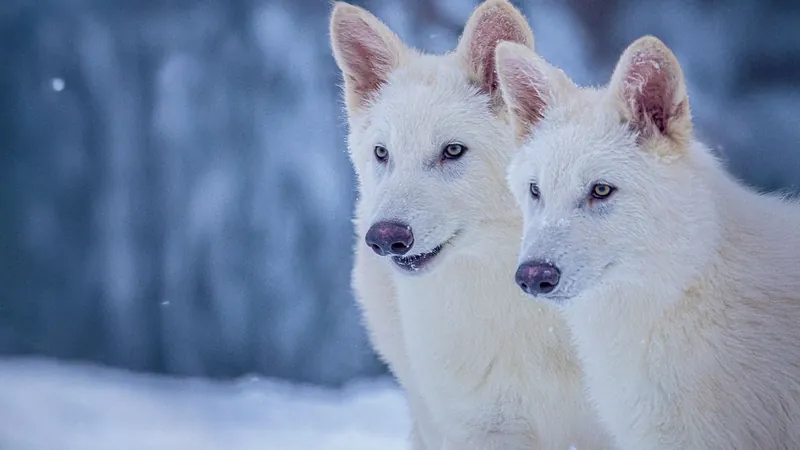
Dire Wolves Reborn: The Groundbreaking Journey of Genetic Resurrection!
2025-04-07
Author: Jessica Wong
In a stunning scientific breakthrough, dire wolves—extinct for an astounding 12,500 years—have been revived through the marvels of genetic engineering. This incredible achievement is being hailed as "the world's first de-extinction," according to researchers at Colossal Biosciences, a pioneering biotech conservation firm renowned for its mission to resurrect woolly mammoths.
Utilizing ancient DNA, scientists have successfully birthed three dire wolf pups—named Romulus, Remus, and Khaleesi—by carefully reconstructing the dire wolf's genome. By comparing their genetic material with that of modern-day carnivores, researchers were able to isolate unique genetic traits specific to the long-extinct Aenocyon dirus, giving life to these extraordinary new pups in a manner not seen before in history.
The process involved sampling DNA from a 13,000-year-old tooth and a 72,000-year-old skull, a feat that Colossal CEO Ben Lamm described as a "magical" achievement in genetic science. He passionately shared, "Our team gets to unveil some of the magic they are working on," highlighting the blend of cutting-edge technology and ancient biology that brought these wolves back to life.
Creating the Impossible: The Science Behind De-Extinction
To achieve this remarkable feat, the team employed a cloning process akin to that used for Dolly the sheep in 1996. They meticulously transplanted genetic material from reconstructed dire wolf cells into denucleated egg cells derived from modern gray wolves (Canis lupus)—the closest living relatives of dire wolves. This high-tech undertaking required deep genomic analysis, identifying key differences in genes that contributed to the unique characteristics of dire wolves, including their larger size, distinctive white coat, and notable howling.
By utilizing CRISPR gene-editing technology, the scientists made precise edits to ensure that the DNA of living gray wolves matched that of their ancient relatives. Following the creation of these "dire wolf cells," they produced multiple embryos, ultimately leading to successful implantation in surrogate domestic dogs (which are technically subspecies of gray wolves).
After a prolonged gestation period, two healthy pups—Romulus and Remus—were born via cesarean section on October 1, 2024, and a third pup, Khaleesi, followed shortly thereafter. Colossal has shared footage capturing these puppies' first adorable moments, from their initial steps to their playful howls, as they grow up, embodying the essence of their ancestors.
Looking Towards the Future
Although this achievement is monumental, it must be noted that Colossal is not the only entity engaged in de-extinction efforts. In 2003, a cloning attempt in Spain produced a Pyrenean ibex, a type of wild goat, but sadly, the newborn didn’t survive more than a few minutes post-birth.
Colossal has not only focused on dire wolves; they have recently announced the successful birth of two litters of cloned red wolves, the most critically endangered wolf species on the planet. As genetic technologies continue to advance, the quest for reviving other extinct species may soon become a reality.
This extraordinary endeavor raises pressing ethical questions and sparks debates about the implications of reviving extinct species. What does it mean for ecosystems, conservation efforts, and our understanding of biodiversity? As we stand on the brink of a new era in science, it becomes essential to explore both the possibilities and responsibilities that come with playing god in nature.
Stay tuned as Colossal continues to push boundaries in genetic research, and as we anticipate what other extinct wonders might be brought back to life!


 Brasil (PT)
Brasil (PT)
 Canada (EN)
Canada (EN)
 Chile (ES)
Chile (ES)
 Česko (CS)
Česko (CS)
 대한민국 (KO)
대한민국 (KO)
 España (ES)
España (ES)
 France (FR)
France (FR)
 Hong Kong (EN)
Hong Kong (EN)
 Italia (IT)
Italia (IT)
 日本 (JA)
日本 (JA)
 Magyarország (HU)
Magyarország (HU)
 Norge (NO)
Norge (NO)
 Polska (PL)
Polska (PL)
 Schweiz (DE)
Schweiz (DE)
 Singapore (EN)
Singapore (EN)
 Sverige (SV)
Sverige (SV)
 Suomi (FI)
Suomi (FI)
 Türkiye (TR)
Türkiye (TR)
 الإمارات العربية المتحدة (AR)
الإمارات العربية المتحدة (AR)